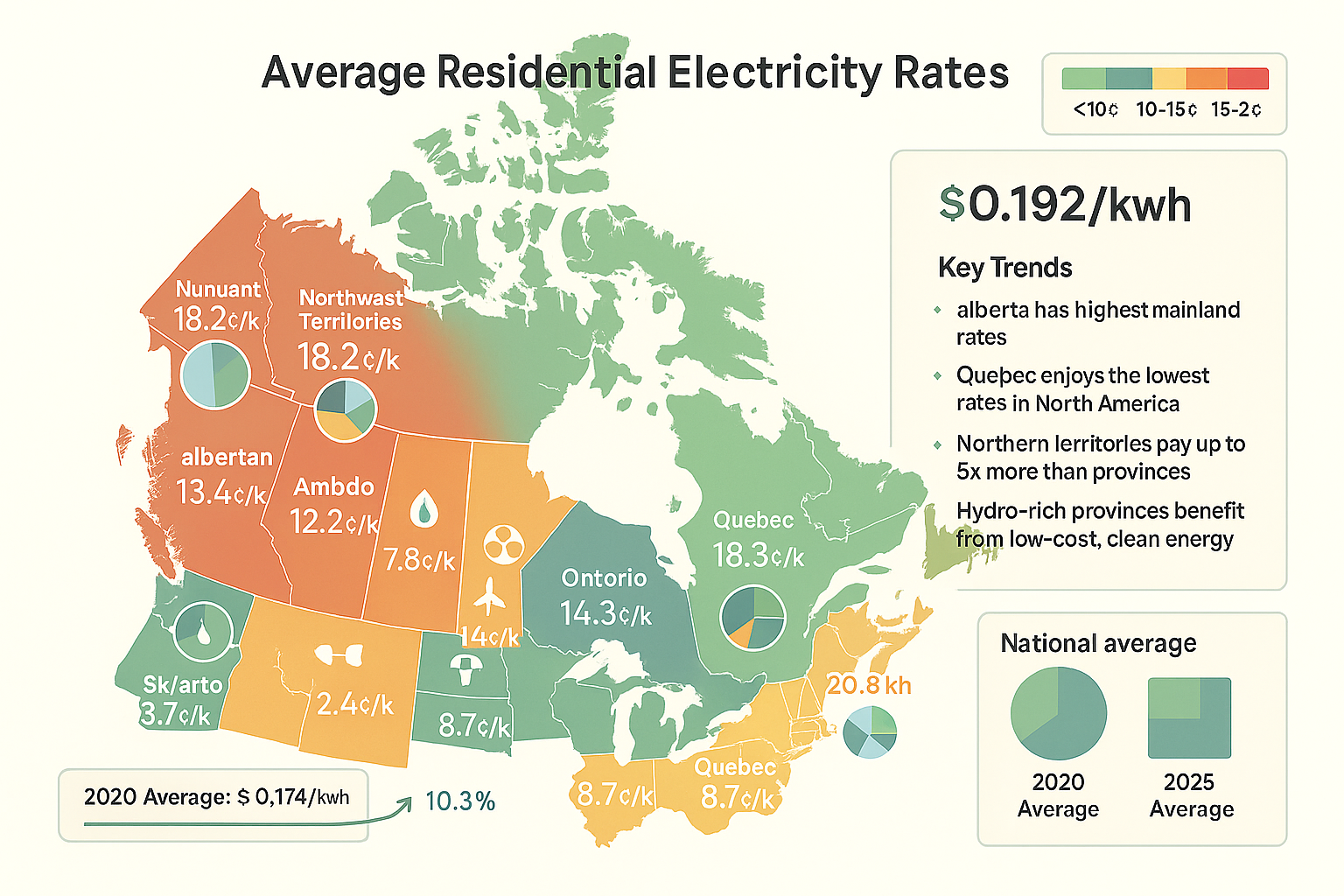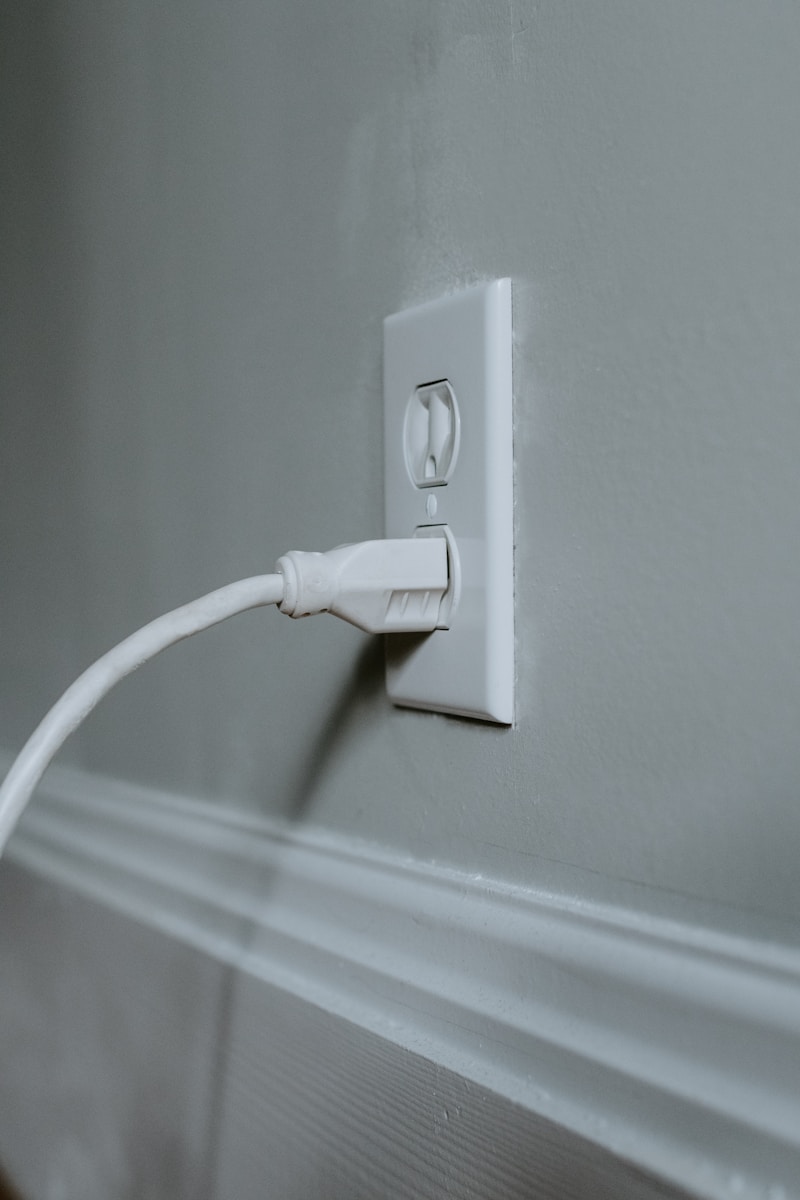Average Electricity Bill in Canada: Provincial Breakdown
Canada’s electricity landscape is as vast and diverse as its geography. From the hydro-powered provinces of Eastern Canada to the fossil fuel-dependent Prairies and the remote, diesel-reliant territories, the cost of electricity varies dramatically across the country. In 2025, these disparities are more pronounced than ever, shaped by energy sources, infrastructure challenges, policy frameworks, and climate demands.
Understanding these differences is essential—not just for households trying to manage rising utility bills, but also for policymakers planning for a clean energy future. Let’s break down the current state of provincial electricity costs in Canada, explore what drives them, and look at how consumers can navigate this complex system.
National Overview: Power Production and Pricing Trends
Canada ranks 7th globally in electricity generation, producing over 639 terawatt-hours (TWh) annually. The backbone of this production is hydropower, which accounts for 61.6% of total generation. Nuclear energy contributes 12.9%, natural gas 12.6%, and other renewables like wind and solar make up the remaining 8%.
Despite this abundance, residential electricity prices have risen significantly in recent years. As of 2025, the national average rate stands at $0.192 per kilowatt-hour (kWh)—a 10.3% increase since 2020. However, when excluding the three northern territories, the average drops to $0.155/kWh, highlighting the extreme price disparity between regions.
Key National Stats:
- Primary Generation Source: Hydroelectricity
- Largest Consumer Sector: Industry (38.4% of total use)
- Territorial Premium: Residents pay 2–5 times more than those in the provinces
Provincial Breakdown: From Lowest to Highest Rates
The cost of electricity across Canadian provinces reflects a mix of resource availability, market structure, and geographic challenges. Here’s a ranking from lowest to highest rates:
1. Québec – 7.8¢/kWh
Québec remains the most affordable province for electricity, with an average monthly bill of $78 for 1,000 kWh. This is thanks to its massive hydroelectric infrastructure, public ownership model, and low distribution costs. The province generates nearly 94% of its electricity from hydro, ensuring both stability and affordability.
2. Manitoba – 10.2¢/kWh
With abundant hydro resources and a relatively small population, Manitoba enjoys some of the lowest rates in the country. Its export of surplus hydroelectric power helps subsidize local costs, keeping bills around $102/month.
3. British Columbia – 11.4¢/kWh
British Columbia benefits from strong hydroelectric generation, but rising wildfire mitigation costs have pushed rates up 26% since 2022, bringing them above the national average. Monthly bills now average $114.
4. Ontario – 14.1¢/kWh
Ontario uses a nuclear and thermal hybrid system, supplemented by renewables. It has a time-of-use pricing model, where rates vary depending on demand:
- Off-Peak: 7.6¢/kWh
- Mid-Peak: 12.2¢/kWh
- On-Peak: 15.8¢/kWh
A typical household pays around $141/month, though additional fees like the “Global Adjustment” can add $20–$50 to monthly bills.
5. Newfoundland and Labrador – 14.8¢/kWh
While Newfoundland has access to large hydro projects like Muskrat Falls, outdated infrastructure and inefficiencies keep rates higher than expected. Average monthly bills come out to $148.
6. Nova Scotia – 18.3¢/kWh
Still heavily reliant on coal, Nova Scotia faces one of the highest regional electricity costs at $183/month. The province is working toward cleaner energy, but progress is slow due to aging infrastructure and high transition costs.
7. Prince Edward Island – 18.4¢/kWh
Despite generating 99% of its electricity from wind, PEI still faces high costs due to its reliance on imported power during low-wind periods. The result is a $184 monthly bill for the average user.
8. Saskatchewan – 19.9¢/kWh
Saskatchewan’s electricity system is dominated by coal and natural gas, contributing to high emissions and volatile pricing. Sparse population density also increases transmission costs, pushing the average bill to $199/month.
9. Alberta – 25.8¢/kWh
Alberta has the highest mainland electricity rates, with an average monthly bill of $258. The province relies heavily on natural gas (49%), and deregulated markets expose consumers to price volatility. Natural gas price spikes in 2022–2024 caused a 54% increase in bills since 2020.
10. Nunavut – 35.4¢/kWh
Remote communities and heavy dependence on diesel generators lead to exorbitant costs in Nunavut. Households pay $354/month, with limited options for reducing consumption or switching providers.
11. Northwest Territories – 41.0¢/kWh
At 41¢/kWh, the NWT has the most expensive electricity in Canada. Like Nunavut, it depends on diesel fuel for over 90% of its generation, combined with extreme transportation costs and a small customer base.
What Drives These Differences?
Several key factors contribute to the wide variation in electricity costs across provinces:
1. Energy Mix
- Hydro and nuclear provinces (Quebec, Ontario, Manitoba) enjoy the lowest rates.
- Fossil fuel-dependent provinces (Alberta, Saskatchewan) face higher volatility and rising costs.
2. Infrastructure and Geography
- Remote and rural areas incur higher delivery charges due to long-distance transmission needs.
- Aging grids in Atlantic Canada require costly upgrades after increasing exposure to extreme weather events.
3. Policy and Regulation
- Deregulated markets like Alberta offer retail competition but expose consumers to unpredictable rate swings.
- Public utilities in BC and Manitoba provide stable pricing but may lag in renewable innovation.
4. Climate and Demand Patterns
- Cold winters drive up usage, especially in heating-dependent provinces like Ontario and Alberta.
- Quebec sees a 67% increase in winter consumption compared to summer due to electric heating.
Strategies to Lower Your Bill
While many factors affecting electricity costs are beyond individual control, there are steps consumers can take to reduce their bills:
Time-of-Use Management (Ontario)
In Ontario, shifting energy-intensive tasks (like laundry or EV charging) to off-peak hours (nights and weekends) can cut costs significantly. For example, using electricity during off-peak hours (7.6¢/kWh) instead of peak (15.8¢/kWh) can save nearly 50% on that portion of the bill.
Fixed-Rate Contracts (Alberta)
Alberta residents can lock in fixed-rate plans (typically 12–36 months) to protect against price spikes. While these plans may cost slightly more during cheaper periods, they offer peace of mind during volatile times.
Efficiency Programs and Rebates
Many provinces offer incentives for energy-saving upgrades:
- Smart thermostats (Alberta): Save 10–15% on heating costs.
- Heat pump subsidies (Nova Scotia): Cut heating expenses by up to 50% compared to electric furnaces.
Renewable Integration
Solar panels, battery storage, and community microgrids are becoming increasingly accessible. In Alberta, the rapid growth of renewable energy could stabilize long-term prices and reduce reliance on fossil fuels.
The Future of Electricity in Canada
As Canada moves toward a decarbonized future, several trends will shape the electricity landscape:
Electrification Boom
Electric vehicles (EVs), heat pumps, and electrified industry are expected to increase residential electricity demand by 40% by 2035. This surge will require significant investment in grid capacity and infrastructure.
Grid Modernization
Major projects like Ontario’s $26 billion nuclear refurbishment program and British Columbia’s wildfire resilience upgrades will help ensure reliability—but likely come with higher delivery charges in the short term.
Climate Impact
Extreme weather is already affecting demand. In February 2025, cold temperatures caused a 14.3% year-over-year spike in electricity demand, signaling a trend that could continue with more frequent weather extremes.
Understanding Your Energy Reality
Canada’s electricity system is a patchwork of advantages and challenges. While Quebecers enjoy North America’s lowest rates at 7.8¢/kWh, Albertans grapple with volatile pricing, and northern residents face steep premiums due to isolation and diesel reliance.
These disparities reflect broader themes – energy independence, policy direction, infrastructure health, and environmental impact. For consumers, the key takeaway is clear: understanding your province’s electricity rate structure and available tools is essential to managing costs.
As the nation continues to electrify and decarbonize, balancing affordability with sustainability will be one of the defining challenges of the coming decades. Whether through smart energy use, efficiency programs, or renewable investments, every Canadian has a role to play in shaping a cleaner, more affordable energy future.







